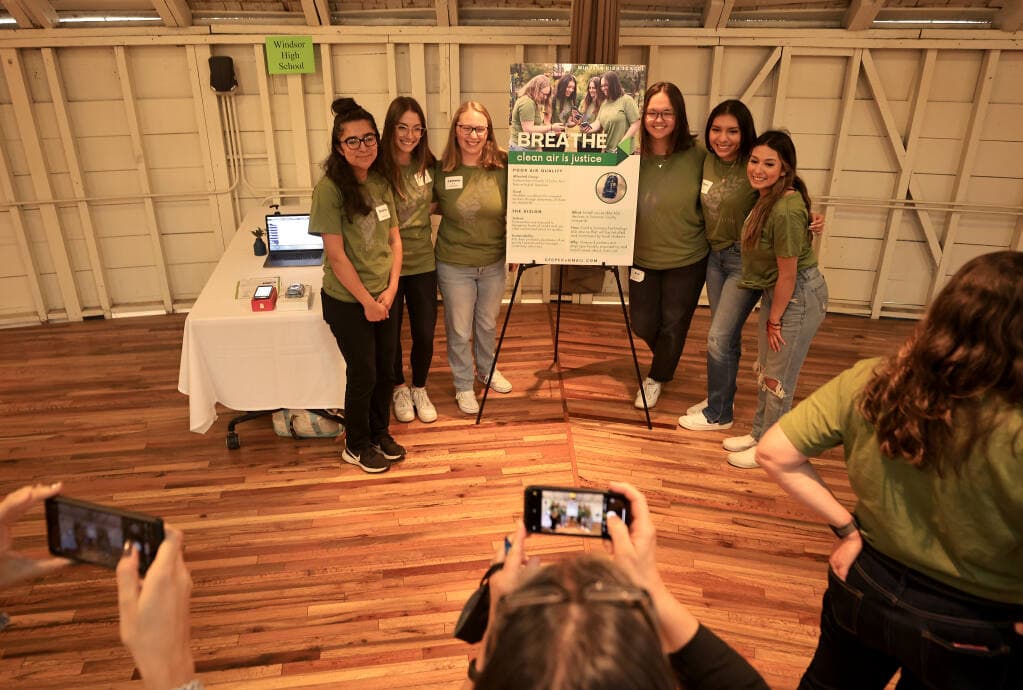In one school-year, dozens of ambitious Sonoma County middle and high school students tackled local environmental issues ranging from vineyard pesticide use to landfills’ effect on air quality.
The 58 students from nine schools across the county were part of Sonoma County Office of Education‘s first Environmental Justice Coalition, which kicked-off in September and resulted in youth-led research and action.
On Thursday, students presented their projects in a “sharecase” at the DeTurk Round Barn in Santa Rosa, where four groups received grants of up to $1,500 to continue their work.
The program was devised by the Office of Education to support and empower the younger generation, which stands to suffer the most from worsening environmental crises over their lifetime, including intensifying wildfires, deadly floods and historic droughts.
Another mission was to foster civic engagement and inspire partnerships with disadvantaged communities that have been disproportionately impacted by environmental damage and disasters, said Matt O’Donnell, Tech Innovation Specialist for SCOE.
Nichole Warwick of Daily Acts talks with Technology High students including Quinn Shioda during an Environmental Justice Coalition kick-off event at Sonoma County Office of Education in Santa Rosa, Calif., on Thursday, September 23, 2021. (Beth Schlanker/The Press Democrat)
New local program is helping prepare the next generation of climate leaders
“It makes me hopeful,” O’Donnell said. What impressed him the most was seeing all the students give up their free time to dive into local environmental issues, even during the peak of the omicron wave.
At Thursday’s event, an audience of approximately 50 people viewed the students’ short videos outlining their research and outcomes. Afterward, the students gathered around informational posters they had made to answer questions.
Quinn Shioda, 17, a senior at Technology High School, wrote about the coalition in her application essay for UC Berkeley, which she’ll attend in the fall.
“I talked about learning to use my voice,” Shioda said.
She said the coalition also taught her that “contributing to change can consist of smaller acts on a local scale.”
Her group, “The Green Girls” from Technology High School, tested air quality in different neighborhoods near the Central Landfill on Mecham Road west of Petaluma and compared it to air quality in higher elevations. They also made an informative website about the issue.
A group from Windsor High School also tested air quality, but for vineyard workers, who often have to harvest when air quality reaches hazardous levels during wildfire season. They received a $1,500 grant to purchase Air Quality Index monitoring devices for the workers.
The ECO2school Youth Leadership Program team researched waste-management issues and is coordinating a community waste education event on May 17 at 4:30 p.m. at Chop’s Teen Club in Santa Rosa.
Many of the students who had first met only a year ago to brainstorm their topic ideas, have come out more confident in their ability to create tangible change.
Many also enjoyed connecting with other youth who are eager to do the same.
Jesenia Garcia, a senior in the ECO2school Youth Leadership Program, said her favorite part of the coalition was getting to meet and work with other students who are passionate about environmental issues.
The best part was “realizing what we can do right now,” Garcia said.
The youngest group in the coalition from Willowside Middle School created a video to raise awareness about pesticides used on farms in Graton and the adverse effects on people and animals.
“This generation has inherited a bunch of problems that we didn’t start,” said Alexis Padron, an eighth grader at Willowside. “So, it’s nice that we’re coming up with different ways to fix it.”


